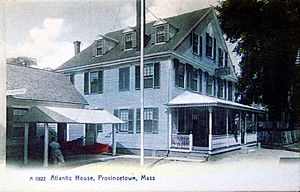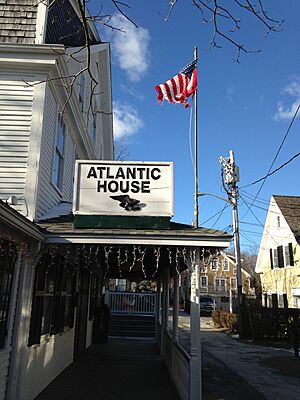Atlantic House facts for kids
The Atlantic House (also known as the A-House) is a very old building in Provincetown, Massachusetts. It has been open for more than 200 years! It's located on the tip of Cape Cod. This historic place is famous for being a welcoming spot for many different people for a very long time. Some even say it's one of the oldest places like it in the United States.
Contents
A Historic Building: The Atlantic House
Early Days of the A-House
The oldest part of the Atlantic House was built in 1798. Daniel Pease, Provincetown's first postmaster, built it. He ran it as a tavern, which is like an old inn or restaurant. After he passed away in 1834, Benjamin Allstrum bought it. It was then called the Allstrum House. It was the last stop for stagecoaches coming from Orleans. This was until trains arrived in 1873.
When Benjamin Allstrum died in 1871, Frank Potter Smith bought the Allstrum House. He was a Portuguese sailor who came to town when he was eighteen. At some point, the original building was connected to a much larger one. This new part had guest rooms. Smith renamed the business the "Atlantic House Hotel." It has been called the Atlantic House ever since.
The A-House in the 1900s
In the early 1900s, Provincetown changed. The whaling industry, which was very important, became less so. The town then became a popular place for artists and writers. Before World War I, traveling overseas became risky. So, a creative and free-spirited way of life became popular in Provincetown. The Atlantic House became a central place for these artists and writers to gather.
In 1917, after the United States joined World War I, something interesting happened. Reuben Kelly, who was part of the Masonic Lodge next door, arrested two men at the Atlantic House. These men were playwright Eugene O'Neill and his friend Harold de Polo. People thought they might be spies. They had carried a black box to the dunes near a government radio station. But the box did not have spy equipment. It only had a Smith Corona typewriter!
Today, a special sign on the outside of the Atlantic House remembers Eugene O'Neill. It notes that he spent time there in the 1910s and 1920s. Part of his play, The Iceman Cometh, was written during his stay. The Atlantic House was also a favorite spot for other famous writers of that time.
In 1950, Reginald "Reggie" Cabral and Mr. and Mrs. Frank J. Hurst bought the A-House. Reggie Cabral became the manager. He soon took full ownership. He made the Atlantic House openly welcoming to everyone. Cabral loved art. He decorated the place with special items. These included a carved wooden figure from an old whaling ship. He also had signed artworks by famous artists like Andy Warhol and Keith Haring.
Exploring the A-House Layout
For many years, the Atlantic House has had several different areas.
- The original tavern is now called the Little Bar. It is a cozy space with a fireplace and a jukebox.
- Upstairs from the Little Bar is the Macho Bar. This area is decorated with posters and images.
- In the larger part of the building, the ground floor has a nightclub with a dance floor.
- The area upstairs from this used to be hotel rooms. Now, it is mostly used for storage.
- A small building across Masonic Place was once a storage space. It is now a restaurant called Grand Central.
- In the 1990s, a new outdoor area was added. This expanded the nightclub's space greatly.
One person who visited the A-House wrote about it. They said that even with other places nearby, the A-House brings in the most people to dance. They also enjoy hanging out on the large outdoor patio. During the summer, it's a great place to go dancing.
Many parts of the Atlantic House have a "nautical" or sea-themed feel. This is thanks to decorations like harpoons and oars hanging from the ceiling.
Images for kids
See Also





